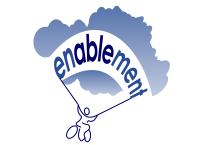Diagnosis of Cerebral Palsy
Top Contributors - Michelle Lee, Laura Ritchie, Naomi O'Reilly, Roelie Wolting, Kim Jackson, Admin, Simisola Ajeyalemi, Jess Bell, Evan Thomas, Rucha Gadgil and Amanda Ager
Introduction
[edit | edit source]
The information on this page has developed for you from the expert work of Roelie Wolting alongside the Enablement Cerebral Palsy Project and Handicap International Group.
Diagnosis[edit | edit source]
Diagnosing cerebral palsy takes time, and is usually not made until the brain is fully developed, the age of a child when diagnosed can vary between the ages of two to five years old. Exceptions do exist, but this is usually in severe cases when the child may be diagnosed soon after birth. Although in general the average age of diagnosis for a child with spastic diplegia, a very common form of cerebral palsy, is 18 months.
There are no definitive tests that confirms or rules out cerebral palsy. The process of diagnosing cerebral palsy involves monitoring the child's development and watching for possible signs of impairment. Often, parents are first to notice their child has missed one of the age-appropriate developmental milestones, like rolling, crawling, sitting and walking. In many countries there is are systems of monitoring the growth, development and health of children under 5 year. This may be where the first signs are cerebral palsy are identified.
Indications for motitoring[edit | edit source]
There are guidelines on when infants and children should meet developmental milestones which are usually monitored by health care professionals, so if achievement of a milestone is late this can indicate a reason for motitoring. For more information on developmental milestones have a look at this page.
What parents may identify[edit | edit source]
The primary indicators parents will notice are developmental delay and impaired muscle tone. Developmental delays occurs when a child does not develop specific skills within the predicted time period. If parents are worried about the development of their child it is important to take them seriously. Young babies may show some of these signs:
- Stiffness
- Floppiness
- Slow development
- Poor feeding
- Unusual behaviour
What professionals may observe[edit | edit source]
Professionals should use the input of the parents as basis for further examinations (history or assessment). In the case of cerebral palsy, developmental motor delay is a key indicator. The professional should evaluate:
- Muscle tone
- Movement coordination and control
- Reflex irregularity
- Posture
- Balance
- Fine motor function
- Gross motor function
- Oromotor function
To find out more about normal development see this page.
Medical History[edit | edit source]
Doctors will want to know about the child’s prenatal history, as well as any complications during pregnancy, labour and delivery. If the child’s condition is showing signs of progression, these signs will help doctors rule out a cerebral palsy diagnosis. Like many aspects of diagnosing cerebral palsy, this requires observation over time. Eliminating other possibilities is a crucial factor in diagnosis of cerebral palsy. Both parents’ medical histories are important to this process. By reviewing medical history of parents, doctors can look for possible genetic, progressive, or degenerative nervous system disorders.
Medical Examination[edit | edit source]
Common tests by neurologists or neuroradiologists, may include neuroimaging, such as cranial ultrasound, computed tomography scan (CT Scan), and magnetic resonance imaging scans (MRIs). These tests will allow neurologists to actually “see” the brain. Various disorders, injuries, and conditions yield different results. These can be used to rule out cerebral palsy. Or, if cerebral palsy is eventually diagnosed, they can provide doctors an exact picture of the injury to the brain. Seizure activity will also be monitored if present.
Other specialists can be brought in to test hearing, vision, and perception, as well as cognitive, behavioral, and physical development. A child may be sent to an orthopedic surgeon to ascertain delay in motor development, record persistence of primitive reflexes, examine for dislocated hips, and check on abnormal postural reactions
Reflexes are also something which are examined by medical professionals. In the newborn they are known as primitive reflex movements. These are complex, stereotypical patterns that occur in response to a variety of sensory stimuli. At birth almost all motor behavior is controlled by these primitive reflexes. Within a few months, they are replaced by a more mature set of protective and postural reflexes called advanced postural reactions that position the body segments against each other and gravity. Advanced postural reactions provide the basis for trunk balance and voluntary control of movements. The child gains motor skills as primitive reflexes are supressed and advanced postural reactions are established.









